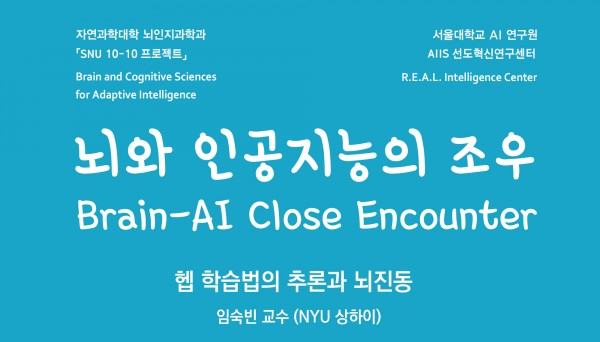행사안내 [AI웨비나] 뇌와 인공지능의 조우 Brain-AI Close Encounter (임숙빈 교수, NYU Shanghai)
페이지 정보
작성일 20-07-30 00:00본문

NYU 상하이의 임숙빈 박사가 "헵 학습법칙에 따른 인지적 추론과 뇌 리듬"을 주제로 발표합니다.
"최근 인공지능에서 딥러닝의 성공에도 불구하고 생물학적 뇌의 작동기전과 다소 동떨어진 측면과 one-shot 학습에 가까운 자연학습에 적용하기 어려운 점은 보다 나은 인공지능의 구현을 위해 여전히 더 많은 연구가 이루어져야 함을 시사합니다. 반면, 뇌 신경세포 간의 학습에 중요하다고 여겨지고 있는 도널드 헵(Hebb) 식의 학습법칙은 매우 단순하면서도 국소적 규칙만으로 충분하다는 장점에도 불구하고, 계산과학적으로 구현하기에 효율적이지 않다는 단점이 있습니다. 본 강연에서는 최근 헵의 학습법칙에 대한 연구결과를 소개하고 살아있는 동물 모델의 실험 데이터로부터 헵의 학습법칙을 이끌어 내는 새로운 방법론을 소개하고자 합니다. 이 방법을 재인(recognition) 과제를 수행하는 영장류 모델의 IT(interior temporal) 피질의 신경세포 활동 데이터에 적용하여 어떻게 헵식 학습규칙이 신경회로의 역동적인 특성을 조절하며 뇌 신경망의 리듬을 만들어내는지에 대해 이야기 해 보고자 합니다." - 발표자
SNU 10-10 프로젝트 Brain and Cognitive Sciences for Adaptive Intelligence와 서울대 AI 연구원 인공지능선도혁신센터 REAL Intelligence Center가 공동으로 개최하는 뇌와 인공지능의 조우 Brain-AI Close Encounter 강연 시리즈 첫번째입니다.
Hebbian learning, its inference, and brain oscillation
Sukbin Lim, Ph.D (NYU Shanghai / SNU BCS Visiting Faculty)
Despite the recent success of deep learning in artificial intelligence, lack of biological plausibility and labeled data in natural learning still poses a challenge in understanding biological learning. At the other extreme lies Hebbian learning, simplest local and unsupervised one, yet considered to be computationally less efficient. In this talk, I would touch upon the recent development of Hebbian learning and introduce a novel method to infer its form from in vivo data. Applying the method to the data obtained from the monkey inferior temporal cortex for the recognition task indicates how Hebbian learning changes the dynamic properties of the circuits and may promote brain oscillation.
댓글목록
등록된 댓글이 없습니다.






